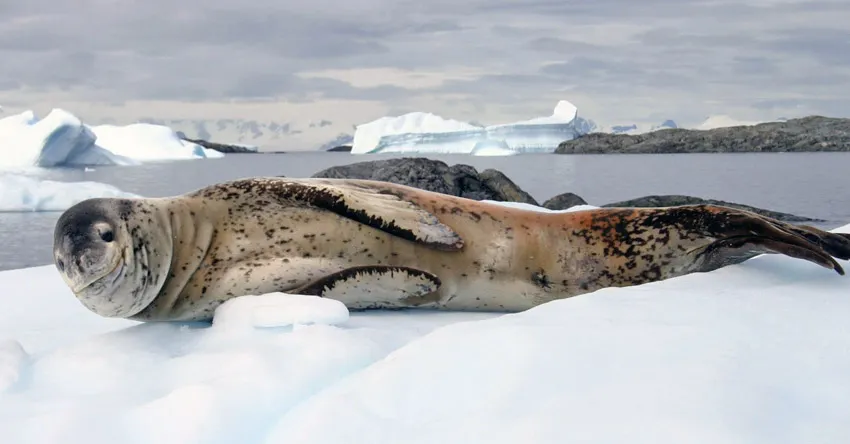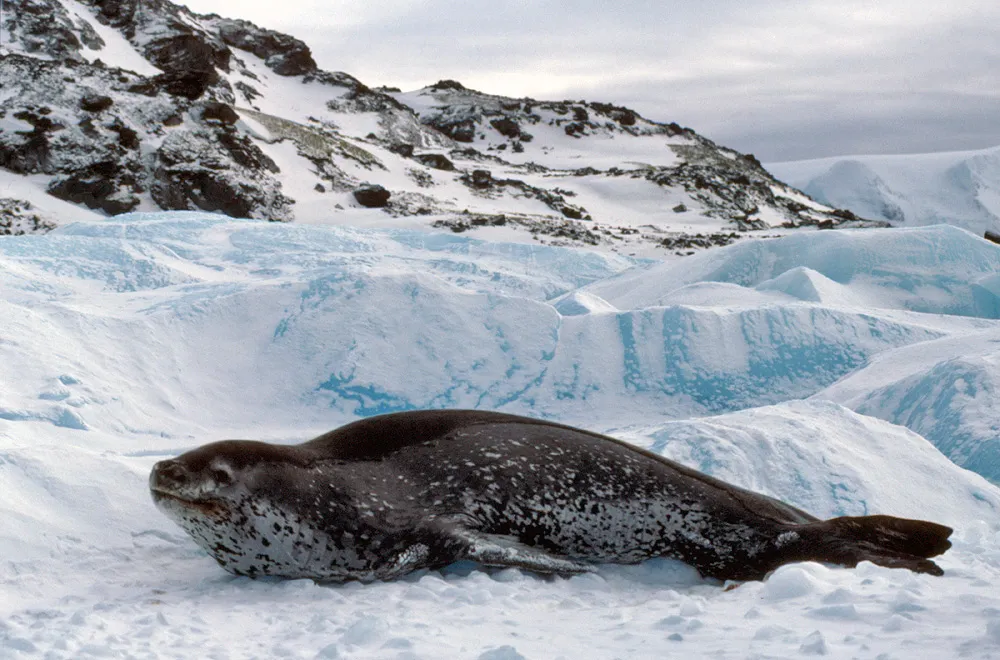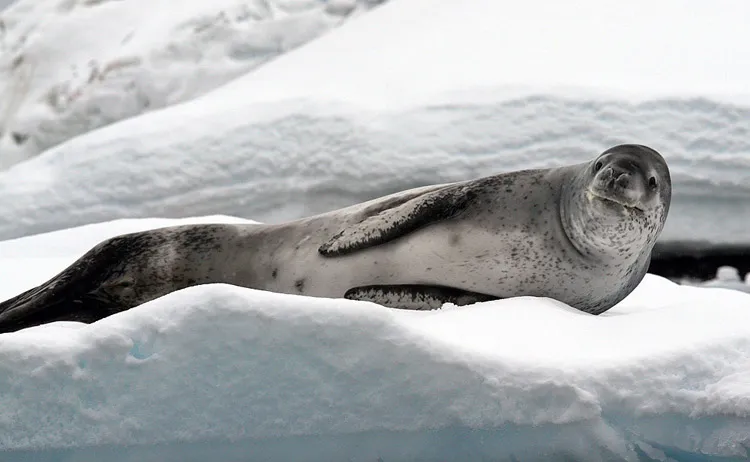Leopard Seals - Hydrurga leptonyx
Named for the spotting on its underside, the Leopard Seal is one of the largest predators in Antarctica, smaller only than the killer whale.
Leopard Seal facts - Basics
Weight: Males up to 300 kg / females
260 - 500 kg.
Length: Males typically
2.8 - 3.3 m / females 2.9 - 3.6 m, up to 3.8m
Breeding Season: Pups born on the ice usually
from November to December, though may occur up to a month
earlier or later. In sub-Antarctic Islands such as South
Georgia the birth season is August to September.
Estimated world population: - 200,000 -
400,000 this
estimate is from 2000, low population densities of solitary
animals over vast areas are difficult to estimate.
Feeding & diet: A very varied diet
of any animal that is small enough for them to kill and
eat, which as they are so large gives a large variety of
potential prey. They will eat fish, squid, penguins, other
birds and the pups of other seal species. They have highly
modified rear teeth which have gaps which help them to sieve
out krill from the water. The great majority of prey are
taken in the water, they are ambush hunters.
Diving: Leopard seals are not great divers
when compared to other seals, 15 minutes is the longest
dive recorded, they stay close to open water not diving
great distances beneath continuous ice as other seals do.
They can swim in short bursts at up to 40 kmh (25 mph).
Conservation status: Least concern.
Protected by the Antarctic Treaty and the Convention for
the Conservation of Antarctic Seals.
Distribution:
Circumpolar, ranging quite widely to sub-Antarctic islands
and more northern waters, more so than most Antarctic seals.
They are generally found near quite open pack ice, moving
north as it starts to consolidate. If seen they will generally
be found hauled out on ice floes rather than land, they
may be reliably found near the open water at the edge of
penguin colonies during the breeding season.
Predators: Killer whales, though not very
frequently.
What are Leopard Seals like?
Females are larger than males, leopard seals are often described as looking "reptilian" a look that comes about by having their eyes somewhat to the side of their head rather than facing forwards as do other seals, they don't really have a forehead or a pronounced snout, a very large wide mouth that is upturned at the edges completes the look. I think they look less generic reptile and more sort of dopey dinosaur.
Don't be fooled by the look however, leopard seals are very serious intimidating predators, they are the weight of five or more men, twice as heavy as a lion or as much as a bear. They often appear more squat when hauled out of the sea onto an ice floe where they are nearly always seen, only rarely coming ashore onto land. In the sea, they appear longer, sleeker and almost snake-like in form and movements, though they swim with large fore and hind flippers. They are the second largest Antarctic seal after the Southern Elephant seal, their size is not always apparent in pictures as they are relatively longer and slimmer than other seals and the ice they are usually on doesn't give any size cues.
How do leopard seals feed?
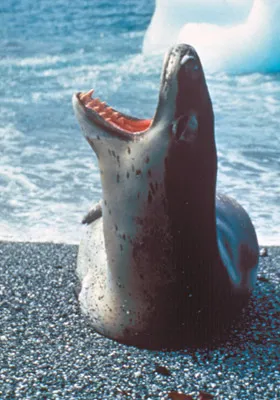 Leopard seals are built for speed, they have
a large powerful head, a huge gape and a massive lower jaw.
They frequent the edge of the pack ice and in particular areas
around penguin rookeries all around Antarctica. They are fairly
opportunistic as predators and will east a wide variety of prey
from krill to penguins to the young of other seals, particularly
crabeater.
Leopard seals are built for speed, they have
a large powerful head, a huge gape and a massive lower jaw.
They frequent the edge of the pack ice and in particular areas
around penguin rookeries all around Antarctica. They are fairly
opportunistic as predators and will east a wide variety of prey
from krill to penguins to the young of other seals, particularly
crabeater.
Their teeth are very much those of a carnivore with large curving canines, though they are also partly adapted with three large cusps on the pre-molars and molars that interlock and are also able to act as a strainer when feeding on krill.
They are inquisitive and fearless, frequently approaching small boats to investigate when their large "grin" and all of those teeth they have can make them appear quite menacing.
Their way of dealing with penguins is quite gruesome. Once caught by either head or feet, the penguin is swung violently in a wide vertical arc and smacked down on the surface of the sea. The leopard seal may continue to do this until the penguin is literally thrown out of its skin and feathers for the seal to then bite into chunks and swallow. Floating penguin skins in the sea are a sure sign of leopard seals nearby.
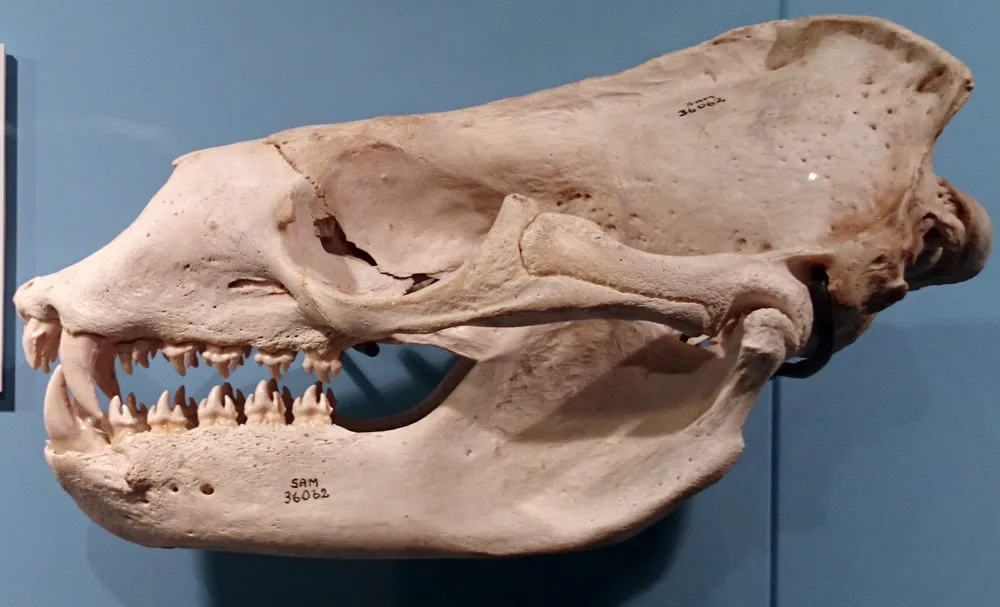
The skull of an adult leopard
seal. Adaptations for predatory feeding can
be seen in the long curved canine teeth, in the lobed
rear teeth used for filter feeding krill out
of the water and in the massive size of the strong lower
jaw with a large area towards the back where the powerful
jaw muscles are attached.
Are leopard seals dangerous to humans?
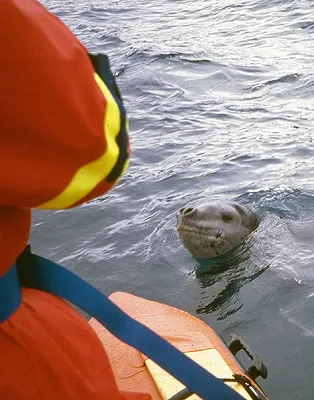 Yes,
leopard seals are more than capable of killing a human.
Yes,
leopard seals are more than capable of killing a human.
They are large predators bigger than any of the big cats and heavier than most bears,. Out of the water they are easy to evade (though see below) to the point where they tend not to bother chasing prey due to their slow and cumbersome movements. In the sea however, where they are perfectly suited and adapted, they could pick off a human with no difficulty should they choose to do so.
Fortunately however, attacks are very rare, partly due to the fact that where leopard seals live, they don't encounter many humans and partly that when they do, they overwhelmingly choose not to attack them.
There are no records of leopard seals attacking humans when they have been seen in advance, they will often interact with divers, showing great curiosity and often a rather disturbingly large open mouth full of big sharp teeth too! Any attacks have been surprise attacks which fit in well with leopard seals being ambush predators. Many recorded instances of aggressive behaviour have been at ice edges where it thought that from below the water the seal has assumed that the human is a penguin standing on the ice edge having emerged from the sea or about to go in.
The only recorded death caused by a leopard seal
To date there is a single recorded fatality caused by a leopard seal. The sad case of 28 year old marine biologist Kirsty Brown who was killed in July 2003 at the British Antarctic Survey Rothera base while snorkeling with a colleague in shallow water about 20m from the shore. She was attacked by a leopard seal that hadn't been seen before the attack, she was heard to scream and then disappeared from view. As a shore party launched a rescue boat she surfaced briefly with the seal and then disappear again, her snorkeling buddy last saw her at a depth of about 5m being held by the seal. Ten minutes later the seal was seen with Kirsty about 1km away holding Kirsty by the head, she was face down. As the rescue boat approached, one of the crew began to hit the surface of the water with a shovel and then when close enough, to hit the seal which released her and swam away.The base doctor attempted resuscitation though after an hour of trying, Kirsty was pronounced dead. She had died from drowning, her depth gauge recorded a maximum depth of 70.1m to which the seal had taken her.
As a result of this incident, all diving or snorkeling activities are preceded by a 30 min watch for sign of leopard seal in the water, all activities are to be supported by boat and if a leopard seal appears anyone in the water must exit as soon as it is safe to do so.
Other rather too close encounters with leopard seals
Shackleton's Imperial Transantarctic Expedition, 1914-17, Lansing 1959, pp. 102 - 103
Returning from a hunting trip, Orde-Lees, travelling on skis across the rotting surface of the ice, had just reached camp when an evil, knoblike head burst out of the water just in front of him. He turned and fled, pushing as hard as he could with his ski poles and shouting for Wild to bring his rifle. The animal - a sea leopard - sprang out of the water and came after him, bounding across the ice with the peculiar rocking-horse gait of a seal on land. The beast looked like a small dinosaur, with a long, serpentine neck. After a half-dozen leaps, the sea leopard had almost caught up with Orde-Lees when it unaccountably wheeled and plunged again into the water. By then, Orde-Lees had nearly reached the opposite side of the floe; he was about to cross to safe ice when the sea leopard's head exploded out of the water directly ahead of him. The animal had tracked his shadow across the ice. It made a savage lunge for Orde-Lees with its mouth open, revealing an enormous array of saw like teeth. Orde-Lee's shouts for help rose to screams and he turned and raced away from his attacker. The animal leaped out of the water again in pursuit just as Wild arrived with his rifle. The sea leopard spotted Wild, and turned to attack him. Wild dropped to one knee and fired again and again at the onrushing beast. It was less than 30 feet away when it finally dropped. Two dog teams were required to bring the carcass into camp. It measured 12 feet long, and they estimated its weight at about 1,100 pounds.
Orde-Lees himself was a little more matter of fact, the last 1/3rd of his diary entry for the day, the 1st of January 1916 reads:
We were lucky enough to get five crab-eaters and a monster leopard over 12 ft long which Wild shot as he was chasing me round a small thin floe. They are really dangerous animals and this was the first I had ever seen, and it gave me a good fright.
There were another two instances during this
expedition when leopard seals made an attack on a man standing
near to the waters edge in a similar manner.
70 day Antarctic expedition In the Footsteps
of Captain Scott's South Pole (Terra Nova) Expedition,
Wood & Jamieson 2000, pp. 179 - 180
Stretching one foot down, I probed it with the tip of my crampon, much as I'd done with dozens of other working cracks in similar circumstances. Suddenly, the surface erupted as the massive head and shoulders of a mature leopard seal, mouth gaping in expectation, crashed through the eggshell covering. It closed its powerful jaws about my right leg, and I fell backward, shocked and helpless in its vise-like grip. Feeling myself being dragged toward a watery grave, I locked my left crampon onto the opposing edge. I knew that once I was in the water, it would be all over.
"Help, help, Steve, Tim, help," I screamed repeatedly. It seemed an age before I finally caught sight of their running figures. "Kick it, kick it, kick it, get the bloody thing off me, hurry, hurry for Christ's sake, you bastard, you bastard," I yelled hysterically, my gloved hands scrabbling fruitlessly for purchase on the smooth ice behind me as I strained against the seal's prodigious weight. For one tiny fraction of a second our eyes met. These were not the pleading eyes of a Weddell seal nor the shy glance of a crabeater seal - they were cold and evil with intent. What fear the seal must have recognized in my own during this brief moment of communication, I can only imagine. "B***y hell, it's a leopard seal," Steve shouted breathlessly as he leapt across the crack to attack the brute from the opposite side. "Get the bloody thing off me, kick it, for Christ's sake," I screamed again. "Aim for its eye, its eye," Tim shouted, his voice verging on panic. "B***d! B***d! B***d!" Steve chanted in rhythm to his swinging boot."Get its eye, blind it," Tim shouted again. I watched, dazed, as the front tines of Steve's cramponed boot made small, fleshy wounds in the side of the beast's head near its eye. 15 or 20 times his foot swung with crushing impact.
Blood streamed from the wounds and spattered to the ice with each sickening smack of the boot. The impact of the violent attack vibrated through my body. Stubbornly, the beast continued to grip my leg which appeared tiny in its jaw. I felt as powerless as a mouse caught by a cat. "It's backing off," Tim shouted triumphantly as the seal suddenly released its hold and slipped slowly back beneath the surface. Numbed, confused and mesmerized by the concentric ripples slapping the edge of the bloodstained hole, I stared entranced at the spot where the frightening beast had disappeared. "Quick, get him back from the edge," Tim gasped. Arms had just grabbed me when the seal's monstrous form leapt once more from its watery lair. Lunging at me, it crossed the ice with an awkward gait, streams of bloody water cascading to the ice around it. Its large, interlocking teeth crushed down on my plastic boot. "My god, we've blown it," I gasped. "Kick it, kick it, for Christ's sake, kick it," I shouted, the fear in my throat threatening to choke me. "Its eye, get its eye," Steve shouted as he and Tim again booted its head with the lance-like front tines of their crampons. Irrational thoughts careered madly about my brain. What would the ice look like from beneath the surface? What would death be like? As if divorced from life already, I pictured the seal swimming down with my limp, red-coated body in its jaws. I could see pale green sunlight filtering down through the ice as I descended into the gloom of certain oblivion. It all seemed so real, so peaceful - a silent movie with myself as the reluctant hero. Tim's tugging at my shoulders pulled me swiftly back to reality finally vanquished, the animal had retreated to its nether world. They skidded me quickly over the ice a safe distance from the crack. I stood up shakily. "Lie down, let's have a look," Steve implored, motioning me down. "No, I'm all right. Thank god it's not broken," I gasped, as I tested my wounded leg by stumbling backward, away from the terror I had just experienced. Glancing down at my torn clothing I saw blood on my leg - whether it was mine or the seal's I was not sure. I unzipped my outer Gore-Tex and fibre-pile pant. "Oh my god," I trembled, horrified at the blood and puncture wounds on the front and back of my leg just below my knee.'
Leopard seals also have something of a reputation for liking (or maybe disliking) the tail ends of inflatable boats known as zodiacs, like the one hanging around the end of the boat in the picture. That was an occasion when I was helping to support a diving team who had gone in the water to film and photograph leopard seals, while they were under water, that one seal kept swimming by and giving us menacing looks, occasionally they would feel the end with their mouth or have a bit of a chomp. Some bases now place guards on the ends of the boats to prevent damage by leopard seals.
Charles et al. 2004, p.. 70 & p. 73. Sea kayaking the Antarctic Peninsula, 2003.
A big leopard seal was picking a gruesome fight to the death with the stern of one of the base's Zodiacs. The seal had the hapless craft in its massive jaws. The zodiac vainly blew air in the seal's face as its teeth tore into the rear pontoon. . . . For some reason leopard seals like the tail ends of Zodiacs: there were 20 or so reported deflations during the summer season.
Copyright picture used by permission: Leopard seal skull - Nkansah Rexford, used under Creative Commons 3.0 Attribution license / Seal on ice between 2 text boxes - Gilad Rom from Israel, used under Creative Commons Attribution 2.0 generic license / Other pictures NOAA or Paul Ward - CoolAntarctica.com
References and bibliography
Charles, G., Jones, M., Waters, M., & Moodie, S. 2004. The Frozen Coast: Sea Kayaking the Antarctic Peninsula. Nelson, N.Z: Craig Potton.
Lansing, A. 1959. Endurance, Shackleton's Incredible Voyage. McGraw-Hill Book Company.
Wood, G., & Jamieson, E. 2000. South Pole: 900 Miles on Foot. Victoria: Horsdal & Schubart.
Shona F Muir, David KA Barnes and Keith Reid, March 2006, Interactions between humans and leopard seals - 93 page report

